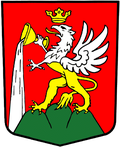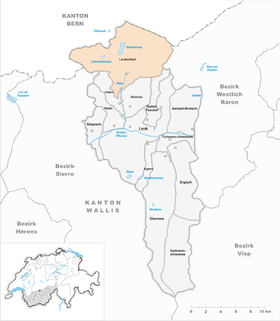Leukerbad
| Leukerbad | |
|---|---|
| State : |
|
| Canton : |
|
| District : | Leuk |
| BFS no. : | 6111 |
| Postal code : | 3954 |
| Coordinates : | 614 978 / 136 903 |
| Height : | 1402 m above sea level M. |
| Height range : | 1232–3694 m above sea level M. |
| Area : | 67.32 km² |
| Residents: | 1368 (December 31, 2018) |
| Population density : | 20 inhabitants per km² |
| Website: | www.leukerbad.org |
|
Leukerbad |
|
| Location of the municipality | |
Leukerbad ( Valais German Leiggerbad , French Loèche-les-Bains ) is a municipality in the district of Leuk in the canton of Valais in Switzerland .
geography
The winter sports and thermal health resort is located in the rear Dala valley ( derived from the Dala river ) at an altitude of 1411 to 2700 m above sea level. M. The valley is bounded on the northwest by the mountain range of the Leeshörnern to the cow horn and Balmhorn , with a deep saddle when Gemmipass , the other side of the valley is dominated by Ferdenrothorn from Majinghorn and its glacier and from Torrenthorn .
history
The hot springs of Leukerbad have been known since Roman times and Leukerbad is still a bathing destination today.
The Maison Blanche is considered the oldest hotel in Leukerbad . The first building was erected in the 17th century and, after being destroyed by avalanches in 1719, it was rebuilt as a five-story stone house with a gable roof . It was the residence of most of the spa guests who arrived until 1830, but it had an increasing reputation for offering poor and neglected rooms.
Leukerbad was hit by serious avalanche disasters four times in the 18th century. After 1719, avalanches reached the town center in 1720, 1756 and 1767 and destroyed many houses.
After the village had received better avalanche protection by 1830, several new hotels were built and the old Maison Blanche was completely overhauled. Unusual for a Valais mountain farming village, a classicist hotel building, the Hotel de France , was built between 1834 and 1836 . After the construction of a drivable road from Leuk to Leukerbad, two more classical buildings followed in the 1840s, the Hotel des Alpes and the Hotel Bellevue . In 1850, Leukerbad already owned seven hotels and guesthouses, making it a pioneer in the development of mountain and spa tourism in the entire Swiss region. All the hotels stood next to the old village center. In order to accommodate the numerous English tourists, an English chapel was built in the village in 1885. At the same time, Leukerbad had a good reputation as a spa . According to the Swiss cure almanac of 1886, the thermal springs should help against "chronic skin diseases, rheumatism, scrofulosis , nervous disorders, bleaching and mental overwork".
By 1896, the electrification of the large hotels was largely complete. In the 1910s, the eight large hotels, which offered a total of 900 beds, all received central heating, and in 1915 a cog railway was built between Leuk and Leukerbad (closed in 1967, route broken). Between 1910 and 1920, an average of 17,000 guests were counted. In 1916, in the middle of the First World War, over 20,000 visitors were counted. In addition to the medical care as part of the spa stay, a sporting program consisting of billiards , lawn tennis, croquet , badminton and table tennis was already part of the offer for the spa guests.
Tourism in Leukerbad underwent fundamental change in the late 1920s and 30s. The wealthy upper class, who had been guests in Leukerbad up until then, had largely lost their wealth. As a result, the guest structure in Leukerbad changed significantly, with the focus increasingly on the middle class as guests.
On May 24, 1957, the Leukerbad– Gemmipass cable car was inaugurated. It allowed the guests to reach the height of the Gemmiwand without having to take the arduous footpath up the Gemmi Pass. It was originally only intended for summer tourism. It was not until the 1960s that Leukerbad developed towards ski tourism.
From 1981, Leukerbad invested heavily in the infrastructure under the new mayor Otto G. Loretan . In a relatively short period of time, the Burgerbad was expanded, the sports arena built, the Alpentherme built , and the town hall and parking garage built. To finance these buildings, the community needed money that it had to raise on the capital market. The debts of the municipality of Leukerbad as of December 31, 1997 amounted to around CHF 170 million. The debts of the group (Leukerbad and municipal companies ) amounted to CHF 344 million. Of this amount, CHF 61 million went to issuers , CHF 85 million to insurance companies and CHF 198 million to banks . With 1,700 inhabitants at the time, the gross debt per capita was CHF 105,000.00 or CHF 202,000. In comparison, the average for the Valais municipalities was CHF 9,500. On 21 October 1998, the Municipal Council of State 128 Municipal Code under partial state was kind according to. Sequestration provided. This mandate was entrusted to three non-cantonal experts. Their task was to draw up a recovery plan that was available in March 1999. They calculated a maximum acceptable debt of around CHF 40 million for the community. A debt waiver of 80% (CHF 144.5 million) was submitted to the creditors, but their approval was not granted. As a result, the canton as a supervisory authority had no other option than to apply to the cantonal court on May 26, 1999 for an advisory board for Leukerbad; on July 20, 1999, the cantonal court decided to place the municipality under an advisory board. From 1998 to 2004, Leukerbad was the first Swiss municipality to be subject to compulsory administration by the canton. In August 2004, in the appeal process for the Leukerbad debacle, the former mayor Loretan was sentenced to five years imprisonment for multiple fraud, multiple disloyal business and administration as well as tax fraud.
population
| Population development | |||||||||||
|---|---|---|---|---|---|---|---|---|---|---|---|
| year | 1850 | 1900 | 1950 | 2000 | 2010 | 2011 | 2012 | 2013 | 2014 | 2015 | 2016 |
| Residents | 557 | 613 | 505 | 1431 | 1633 | 1596 | 1586 | 1535 | 1492 | 1475 | 1433 |
Attractions
- Thermal baths
- Lorenz spring
- Thermal spring jetty
- Gemmiweg
- Daubenhorn via ferrata
- Gemmi via ferrata
- Albine ladders
- Torrenthorn
Parish
The community of Leukerbad belonged to the large parish of Leuk for centuries. Bishop Matthäus Schiner established an independent parish in 1501. As early as 1484, Bishop Jost von Silenen laid the foundation stone for a corresponding church. The church building, which had become too small, was expanded in 1865 when the church was rotated 90 degrees. The inauguration took place in 1866 by Bishop Pierre-Joseph de Preux. Today's main portal on the north side, the bell tower and the side chapel as a former choir go back to the church building from 1484.
The chapel dedicated to Anthony of Padua is in the district of Birchen . The church, first documented in 1705, was last renovated in 1999.
The history of Protestantism in Leukerbad begins at the beginning of the 19th century .
tourism
Gemmi
The Gemmipass was an important link between the canton of Bern and the canton of Valais in the Middle Ages . The Gemmibahn cable car has been running from Leukerbad ( 1411 m above sea level ) to the pass ( 2314 m above sea level ) since 1957 . In 2012 it was renewed. In summer, Gemmi is the starting point for hikers to Kandersteg, Adelboden and for the Daubenhorn via ferrata . The 330 m long Gemmiwand adventure via ferrata was laid out directly below the mountain station .
In winter, cross-country ski trails , toboggan runs, snowshoe trails and winter hiking trails are laid out and the Gemmi is also the starting point for touring skiers in the direction of Wildstrubel , Daubenhorn, Balmhorn and Steghorn . The hiking trail over the Berghotel Schwarenbach to Kandersteg is also open as a winter hiking trail in winter.
Torrent
Torrent is the ski area of Leukerbad and has 50 km of slopes. A cable car runs from Leukerbad to the Rinderhütte ( 2340 m above sea level ), the center of the facilities. The numerous hiking opportunities lead to the summit of the Torrenthorn, on the Restipass to the Lötschental or to the Majingalp and Flüealp.
Personalities
- Joseph Loretan (1806–1876), Grand Councilor (1847–1876), Cantonal Judge (1853–1876)
- Gustav Loretan (1848–1932), Grand Councilor (1877–1913), Council of States (1885–1895), National Council (1895–1908), Cantonal Judge (1907–1929)
- Raymund Loretan (1885–1963), Grand Councilor (1913–1927), Council of States (1920–1928), Council of State (1927–1937), Substitute Judge at the Federal Supreme Court (1925–1954)
- Wolfgang Loretan (1914–2011), State Councilor (1965–1977)
- James Baldwin (1924–1987), writer, processed his memories of a stay in Leukerbad in his essay "Stranger in the Village" (German: "Stranger in the Village")
- Otto G. Loretan (* 1946), Grand Councilor (1993–1997), National Council (1995–1999)
- Pericle Patocchi (1911–1968), writer, died in Leukerbad
- Eduard Zimmermann (1929–2009), German journalist and television presenter, lived with his wife in Leukerbad from 1997 to 2008
literature
- Philipp Kalbermatter: Leukerbad. In: Historical Lexicon of Switzerland . 2008 .
Web links
- Leukerbad on the ETHorama platform
- Official website of the municipality of Leukerbad
- Thermal baths in Leukerbad
Individual evidence
- ↑ Permanent and non-permanent resident population by year, canton, district, municipality, population type and gender (permanent resident population). In: bfs. admin.ch . Federal Statistical Office (FSO), August 31, 2019, accessed on December 22, 2019 .
- ↑ Majing Glacier on ETHorama
- ↑ Canton of Valais, Presidium of the Cantonal Finance Inspectorate of May 19, 2006, p. 2 ff.
- ↑ NZZ from September 1, 2004, Five years in prison for Otto G. Loretan
- ↑ Lorenzquelle on ETHorama
- ↑ Berghotel Schwarenbach on ETHorama
- ↑ Teju Cole : "Black Body: Rereading James Baldwin's 'Stranger in the Village'" . August 19, 2014, ISSN 0028-792X ( newyorker.com [accessed July 13, 2019]).








